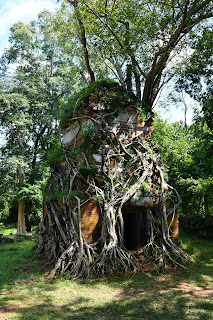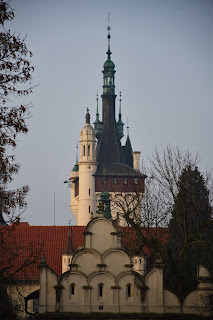Luang Prabang to Angkor – Day 9: Preah Vihear & Koh Ker
We woke up early this morning, as we had booked a tour to go to Preah Vihear and Koh Ker. These temples lie quite far from Siem Reap: the journey to Preah Vihear takes around three and a half hours – or three with a fiendish driver like ours. When we arrived by the ticket office at the foot of the mountain, our guide asked whether we would like to rent motorcycles or a van to ride up. We had already noted our rapidly diminishing supply of riel as we were buying the tickets, so when we learned that the motorcycles cost five dollars each and the van twenty-five, we opted for the former.
Within half
a minute, three men in helmets rode up to the ticket office on their
motorbikes, and before I could even think about asking for my own helmet, I was
already sitting behind one of them. I cursed my lack of foresight as we zoomed
up the steep path, my hands gripping the backseat until they were red, and my
mind fixed on the ride back with abject horror. Once we arrived, our tour guide
proceeded to tell us, laughing, that we he had never taken the motorbike up
before because tourists always request the van. Of course, the fact that I am
writing this blog attests to the fact that I survived even the ride down, but
perhaps only thanks to my telling the excessively young driver “Slow, slow,
please” whenever he approached a steep drop. Barron did not escape unscathed:
he lost his hat.
On the
footpath to the first gateway, we passed by several bunkers made of stacked
sandbags. Our guide explained that these were set up to defend the site from
Thailand, which has long harboured a claim to the temple. Preah Vihear sits
right on the border between the countries, and the narrow way up crosses it
multiple times. This is why there is a small booth right at the border for
monitoring crossings, but I noticed that on our way back it was empty. Nowadays,
at least one guard, oftentimes a woman, is stationed by almost every structure
in the complex to keep an eye on the tourists.
In 1962,
the ICJ ruled that Preah Vihear belonged to Cambodia, but when the temple
became a UNESCO site in 2008, the conflict resumed. Luckily for Cambodia, the
ICJ made another ruling in its favour, settling the case for good.
Interestingly, this whole history has earned the Netherlands much goodwill
among some Cambodians, who see them as responsible for whatever happens at the
Hague. Upon learning that another tourist at the temple was Dutch, my guide
loudly thanked her for her support and explained the situation to some of the
onlooking guards. Confused by the whole situation, they mistook me as the
target of his already misplaced praise, and one of them patted me on the back
as I walked past.
Preah
Vihear stretches around eight hundred metres from its entrance in the north to
the cliff edge that overlooks the Cambodian countryside in the south. On the
way to its main shrine, visitors pass through increasingly impressive
galleries, many of which are still being restored to their former glory. Towards
the beginning of the temple, the tympani above the entrances tend to depict the
god Vishnu standing atop the head of the demon Rahu. Rahu is known in Hindu
mythology as the swallower of the sun and the moon, who told on him to Vishnu
when he stole the elixir of immortality. To punish this transgression, Vishnu
cut off his head, but of course Rahu was already immortal, and his head could
survive on its own.
The main
shrine of Preah Vihear is dedicated to the god Shiva. As is tradition, the god
was worshipped in the form of a lingam, but this artifact has disappeared along
with Hinduism. The shrine now serves as a Buddhist house of prayer. We did not
even cross the threshold to take a better look at the icons inside, as the
place was full of worshippers and their clouds of incense smoke.
We rolled
up to Koh Ker about an hour and a half after leaving Preah Vihear. Koh Ker
briefly served as the Khmer capital under kings Jayavarman IV and Harshavarman
II between the years 928-944 CE. The site spans over thirty square kilometres
and contains over sixty shrines, so we only visited a few. Our first stop was
by a cluster of five shrines, all of them bereft of their lingams with one
broken yoni lying to the side. Barron fell in love with the trees that soar
from the roofs of some shrines while sinking their hefty roots into their
walls. We stopped again by the main temple, which consists of multiple
galleries leading past a water pool to a massive seven-tiered pyramid. I did
not find the view from the top of this pyramid very impressive: all I could see
were trees and a few low hills. Finally, we stopped by two temples which still
had their lingams.
We noted
the information our guide shared with interest, though much of it bore no
relation to the history of the sites we saw; the factoids he did share about
the sites always oscillated between minute retellings of royal histories and sweeping
generalisations about Hinduism. Nonetheless, we learned that two of the three
men we kept seeing on patriotic posters were the former prime minister and his
son, the current prime minister. The guide did not hide his disdain for the
political system that had kept the same political family in power for decades.
He blamed corruption for the high prices of cars, saying that even second-hand
models are subject to prohibitive import taxes, as well as Cambodia’s reliance
on imports from Thailand and Vietnam. Interestingly, he expressed positive
views of the French, noting that although many Khmers dislike France as a
former colonial power, it was French intervention that kept Vietnam and
Thailand from annexing Cambodia entirely.





















Comments
Post a Comment